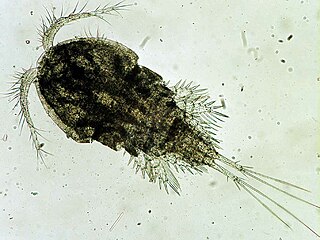
The Cyclopoida are an order of small crustaceans from the subclass Copepoda. Like many other copepods, members of Cyclopoida are small, planktonic animals living both in the sea and in freshwater habitats. They are capable of rapid movement. Their larval development is metamorphic, and the embryos are carried in paired or single sacs attached to first abdominal somite.
Allodiaptomus is a genus of copepods in the family Diaptomidae, containing the following species:
Arctodiaptomus kamtschaticus is a species of crustacean in the family Diaptomidae. It is endemic to lakes in Kamchatka, eastern Russia, and is listed as a vulnerable species on the IUCN Red List.
Erebonectes is a genus of crustacean in family Epacteriscidae, containing two troglobitic species. E. nasioticus was discovered in Bermuda and described in 1985; it is listed as critically endangered on the IUCN Red List. E. macrochaetus was found on Middle Caicos and described in 1994.
Leptocaris is a genus of copepods in the family Darcythompsoniidae. One species, the Mexican endemic L. stromatolicolus, is included on the IUCN Red List as a vulnerable species. The genus contains the following species:
Paradiaptomus excellens is a species of copepod in the family Diaptomidae. It is endemic to South Africa.
Mastigodiaptomus is a genus of Neotropical copepods in the family Diaptomidae. Two of the eight species in the genus are listed as Data Deficient (DD) on the IUCN Red List, and one is listed as a vulnerable species (VU):
Muscocyclops is a genus of copepod crustaceans in the family Cyclopidae, comprising three species found only in South America. Two of the species – Muscocyclops bidentatus Reid, 1987 and Muscocyclops therasiae Reid, 1987 – are endemic to the Distrito Federal in Brazil, and are listed as conservation dependent on the IUCN Red List. The third species is Muscocyclops operculatus.
Odontodiaptomus thomseni is a species of crustacean in the family Diaptomidae. It is found in Uruguay and Venezuela.
Paracyclopia is a genus of copepods in family Pseudocyclopiidae, containing only the species P. naessi. It is endemic to Bermudan karsts and is critically endangered.
Ponticyclops is a genus of copepods in the family Cyclopidae.
Skistodiaptomus is a genus of freshwater copepods in the family Diaptomidae, found across North America. The genus contains eight species, three of which are endemic to the United States and are listed on the IUCN Red List as vulnerable species (VU) or Data Deficient (DD).
Speleoithona is a genus of copepods in the family Speleoithonidae, containing the following species:
Speleophria is a genus of marine copepods in the family Speleophriidae. It contains the following species:
Speleophria scottodicarloi is a species of crustacean in the family Speleophriidae. It is endemic to Chalk Cave, a collapsed cave in Smith's Parish, Bermuda, and it listed as critically endangered on the IUCN Red List. The pool it inhabits also contains Barbouria cubensis, Somersiella sterreri and Paracyclopia naessi.

The Cyclopidae are a family of copepods containing more than half of the 1,200 species in the order Cyclopoida in over 70 genera.

Platycopiidae is a family of copepods. Until the description of Nanocopia in 1988, it contained the single genus Platycopia. It now contains four genera, three of which are monotypic; the exception is Platycopia, with 8 species.
Speleophriidae is a family of copepods, comprising seven genera. All are restricted to anchialine caves, with the exception of Archimisophria, which is found in the hyperbenthos of the depths of the Atlantic Ocean. The genera are:
Pseudocyclopiidae is a family of copepods, comprising the following genera:

The clade Multicrustacea constitutes the largest superclass of crustaceans, containing approximately four-fifths of all described crustacean species, including crabs, lobsters, crayfish, shrimp, krill, prawns, woodlice, barnacles, copepods, amphipods, mantis shrimp and others. The largest branch of multicrustacea is the class Malacostraca.




